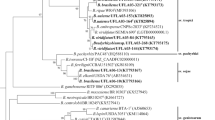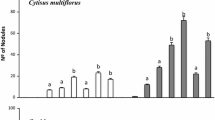Abstract
Background and aims
Bradyrhizobium japonicum and Bradyrhizobium elkanii dominated soybean nodules in temperate and subtropical regions in Nepal, respectively, in our previous study. The aims of this study were to reveal the effects of temperature on the nodulation dominancy of B. japonicum and B. elkanii and to clarify the relationship between the effects of temperature and the climate-dependent distribution of Bradyrhizobium species.
Methods
A laboratory competition experiment was conducted between B. japonicum and B. elkanii strains isolated from the same temperate location in Nepal. A mixture of each strain was inoculated into sterilized vermiculite with or without soybean seeds, and inoculated samples were incubated at 33/27 (day/night) and 23/17 °C. Relative populations in the non-rhizosphere, rhizosphere, and nodules were determined by competitive PCR using specific primers for each strain at 0, 1, 2, and 4 weeks after inoculation.
Results
Both separately inoculated B. japonicum and B. elkanii strains formed nodules at both temperatures. Under competitive conditions, B. japonicum strains dominated at low temperature; however, at high temperature, both strains achieved co-nodulation in 1 week, with B. elkanii dominating after 2 weeks. The relative populations of both strains were similar in the non-rhizosphere and rhizosphere at low temperature, but B. elkanii strains dominated in these regions at high temperature.
Conclusions
The domination of B. japonicum strains in nodules at the low temperature appeared to be due to preferential infection, while the domination of B. elkanii strains at high temperature appeared to be due to the higher population of B. elkanii in the non-rhizosphere and rhizosphere, in addition to its domination in nodules after co-nodulation. The effects of temperature on the competition between B. japonicum and B. elkanii strains were remarkable and corresponded with the distribution of bradyrhizobial species in Nepal.



Similar content being viewed by others
References
Adhikari D, Kaneto M, Itoh K, Suyama K, Pokharel BB, Gaihre YK (2012) Genetic diversity of soybean-nodulating rhizobia in Nepal in relation to climate and soil properties. Plant Soil 357:131–145
Ando S, Yokoyama T (1999) Phylogenetic analyses of Bradyrhizobium strains nodulating soybean (Glycine max) in Thailand with reference to the USDA strains of Bradyrhizobium. Can J Microbiol 45:639–645
Brechenmacher L, Lei Z, Libault M, Findley S, Sugawara M, Sadowsky MJ, Sumner LW, Stacey G (2010) Soybean metabolites regulated in root hairs in response to the symbiotic bacterium Bradyrhizobium japonicum. Plant Physiol 153:1808–1822
Delamuta JRM, Ribeiro RA, Ormeño-Orrillo E, Melo IS, Martínez-Romero E, Hungria M (2013) Polyphasic evidence supporting the reclassification of Bradyrhizobium japonicum Group Ia strains as Bradyrhizobium diazoefficiens sp. nov. Int J Syst Evol Microbiol 63:3342–3351
Fåhraeus G (1957) The infection of clover root hairs by nodule bacteria studied by a simple glass slide technique. J Gen Microbiol 16:374–381
Leonard LT (1943) A simple assembly for use in the testing of cultures of rhizobia. J Bacteriol 45:523–525
Li QQ, Wang ET, Zhang YZ, Zhang YM, Tian CF, Sui XH, Chen WF, Chen WX (2011) Diversity and biogeography of rhizobia isolated from root nodules of Glycine max grown in Hebei Province, China. Microb Ecol 61:917–931
Lindemann WC, Schmidt EL, Ham GE (1974) Evidence for double infection within soybean nodules. Soil Sci 118:274–279
May SN, Bohlool BB (1983) Competition among Rhizobium leguminosarum strains for nodulation of lentils (Lens esculenta). Appl Environ Microbiol 45:960–965
Minamisawa K (1989) Comparison of extracellular polysaccharide composition, rhizobitoxine production, and hydrogenase phenotype among various strains of Bradyrhizobium japonicum. Plant Cell Physiol 30:877–884
Munévar F, Wollum AG II (1981) Growth of Rhizobium japonicum strains at temperatures above 27 °C. Appl Environ Microbiol 42:272–276
Nguyen MT, Akiyoshi K, Nakatsukasa M, Saeki Y, Yokoyama K (2010) Multiple occupancy of nodules by nodulating rhizobia on field-grown soybeans with attendance of Sinorhizobium spp. Soil Sci Plant Nutr 56:382–389
Pan B, Smith DL (1998) Genistein and daidzein concentrations and contents in seedling roots of three soybean cultivars grown under three root zone temperatures. J Agron Crop Sci 180:77–82
Parniske M, Kosch K, Werner D, Müller P (1993) ExoB mutants of Bradyrhizobium japonicum with reduced competitiveness for nodulation of Glycine max. Mol Plant Microbe Interact 6:99–106
Roughley RJ (1970) The influence of root temperature, Rhizobium strain and host selection on the structure and nitrogen-fixing efficiency of the root nodules of Trifolium subterraneum. Ann Bot 34:631–646
Saeki Y, Kaneko A, Hara T, Suzuki K, Yamakawa T, Nguyen MT, Nagatomo Y, Akao S (2005) Phylogenetic analysis of soybean-nodulating rhizobia isolated from alkaline soils in Vietnam. Soil Sci Plant Nutr 51:1043–1052
Saeki Y, Aimi N, Tsukamoto S, Yamakawa T, Nagatomo Y, Akao S (2006) Diversity and geographical distribution of indigenous soybean-nodulating bradyrhizobia in Japan. Soil Sci Plant Nutr 52:418–426
Saeki Y, Ozumi S, Yamamoto A, Umehara Y, Hayashi M, Sigua GC (2010) Changes in population occupancy of bradyrhizobia under different temperature regimes. Microbes Environ 25:309–312
Shiro S, Yamamoto A, Umehara Y, Hayashi M, Yoshida N, Nishiwaki A, Saeki Y (2012) Effect of Rj genotype and cultivation temperature on the community structure of soybean-nodulating bradyrhizobia. Appl Environ Microbiol 78:1243–1250
Someya T, Wang X, Gong C, Koshida K, Nakagawa H, Tanaka C, Ishibashi M, Yokobori K, Inoue K (2003) Rapid and specific detection and enumeration of microorganisms in soil and manure. Soil Microorg 57:115–123
Streeter JG (1994) Failure of inoculant rhizobia to overcome the dominance of indigenous strains for nodule formation. Can J Microbiol 40:513–522
Vincent JM (1970) A manual for the practical study of the root-nodule bacteria. IBP Handbook no. 15. Blackwell, Oxford
Yokoyama T (2005) Effects of temperature on competition for nodulation in phylogenetically different Bradyrhizobium strains. Jpn J Soil Sci Plant Nutr 76:599–607, In Japanese
Yokoyama T (2008) Flavonoid-responsive nodY-lacZ expression in three phylogenetically different Bradyrhizobium groups. Can J Microbiol 54:401–410
Zhang F, Smith DL (1996) Genistein accumulation in soybean (Glycine max [L.] Merr.) root systems under suboptimal root zone temperatures. J Exp Bot 47:785–792
Zhang F, Charles TC, Pan B, Smith DL (1996) Inhibition of the expression of Bradyrhizobium japonicum nod genes at low temperatures. Soil Biol Biochem 28:1579–1583
Zhang H, Prithiviraj B, Charles TC, Driscoll BT, Smith DL (2003) Low temperature tolerant Bradyrhizobium japonicum strains allowing improved nodulation and nitrogen fixation of soybean in a short season (cool spring) area. Eur J Agron 19:205–213
Author information
Authors and Affiliations
Corresponding author
Additional information
Responsible Editor: Euan K. James.
Rights and permissions
About this article
Cite this article
Suzuki, Y., Adhikari, D., Itoh, K. et al. Effects of temperature on competition and relative dominance of Bradyrhizobium japonicum and Bradyrhizobium elkanii in the process of soybean nodulation. Plant Soil 374, 915–924 (2014). https://doi.org/10.1007/s11104-013-1924-5
Received:
Accepted:
Published:
Issue Date:
DOI: https://doi.org/10.1007/s11104-013-1924-5




